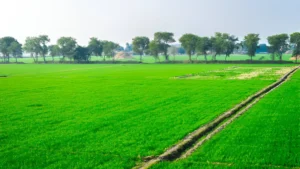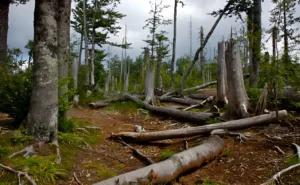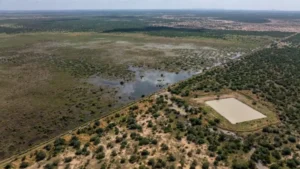Ecosystem Restoration for Economic Growth
- September 5, 2024
- 0 comment
Ecosystem restoration is a critical endeavor that seeks to recover ecosystems that have been degraded, damaged, or destroyed by human activity and natural processes. It is an integral part of addressing global environmental challenges, including biodiversity loss, climate change, and the depletion of natural resources.

The process involves various practices, from reforestation and wetland recovery to the reintroduction of native species and the restoration of natural water flows. This guide is designed to provide beginners with a comprehensive understanding of what ecosystem restoration entails, its importance, and how it can be effectively implemented.
Understanding About The Ecosystem Restoration For Economic Impact
Ecosystem restoration is a growing field that seeks to reverse the degradation of natural habitats, restoring them to a state where they can sustain biodiversity and provide essential ecosystem services. These services include everything from clean water and air to pollination of crops and climate regulation. As the human footprint expands, the importance of restoring ecosystems has become increasingly clear. Not only does this restoration work benefit the environment, but it also has significant economic implications. By improving the health of ecosystems, we can also boost economic growth, create jobs, and enhance the well-being of communities.
The Economic Significance of Ecosystem Restoration
The connection between ecological health and economic prosperity is undeniable. Healthy ecosystems contribute directly to economic activities, particularly in sectors such as agriculture, fisheries, tourism, and forestry. Conversely, degraded ecosystems can lead to economic losses through reduced agricultural productivity, increased disaster vulnerability, and loss of biodiversity. By focusing on the economic benefits of ecosystem restoration, we can create a compelling case for investing in the planet’s natural capital. This guide aims to provide a comprehensive overview of how ecosystem restoration can be approached with an eye toward maximizing both ecological and economic returns.
- Purpose of This Guide: This guide is designed to help beginners understand the basics of ecosystem restoration, with a particular focus on the economic impacts of these efforts. Whether you are a policymaker, a business leader, or a concerned citizen, this guide will provide you with the knowledge and tools needed to make informed decisions about ecosystem restoration projects.
What Is Ecosystem Restoration?
Ecosystem restoration involves a series of processes aimed at returning a degraded or damaged ecosystem to a healthy, functioning state. This may involve replanting native vegetation, reintroducing species that have been lost, and removing invasive species that disrupt the balance of the ecosystem. Restoration is not just about recreating what was lost but about re-establishing the conditions necessary for ecosystems to thrive in the long term. This means considering the dynamic nature of ecosystems and the multiple factors that contribute to their health and resilience.
- Types of Ecosystems: Ecosystems vary widely, and so do their restoration needs. Forests, wetlands, grasslands, and marine ecosystems each have unique characteristics and require different approaches for restoration. For example, forest restoration might focus on reforestation and controlling invasive species, while land restoration could involve re-establishing natural water flows and planting native aquatic vegetation. Understanding the specific needs of each ecosystem type is crucial for successful restoration efforts.
- Drivers of Ecosystem Degradation: Ecosystem degradation is driven by a combination of human activities and natural factors. Deforestation, pollution, overfishing, and climate change are among the leading causes of ecosystem degradation. These activities disrupt the natural processes that maintain ecosystem health, leading to a decline in biodiversity and the loss of ecosystem services. Addressing these drivers is essential for effective restoration, as it ensures that restored ecosystems can sustain themselves over time.
1. Economic Benefits of Ecosystem Restoration
Direct Economic Benefits: One of the most immediate economic benefits of ecosystem restoration is job creation. Restoration projects often require a large workforce, providing employment opportunities in rural and urban areas. In addition to jobs, restored ecosystems can boost local economies by enhancing the productivity of agriculture, fisheries, and forestry. For instance, reforested areas can lead to improved soil quality, which in turn increases crop yields. Similarly, restored wetlands can provide flood protection, reducing the costs associated with flood damage.
Indirect Economic Benefits: Beyond the direct benefits, ecosystem restoration also yields numerous indirect economic benefits. Restored ecosystems contribute to human health by providing clean air and water, reducing the prevalence of diseases linked to environmental degradation. Additionally, healthy ecosystems are more resilient to climate change, helping communities adapt to its impacts and avoid costly damages. Ecosystem services, such as pollination, water purification, and carbon sequestration, further enhance economic stability by supporting agriculture and reducing the need for artificial inputs.
Case Studies of Successful Restorations: Several case studies highlight the economic impact of successful ecosystem restoration. For example, in Costa Rica, reforestation efforts have not only restored biodiversity but also boosted eco-tourism, creating jobs and generating income for local communities. In the United States, the restoration of the Chesapeake Bay has led to improved water quality and a resurgence in the fishing industry, benefiting both the environment and the economy.
2. Key Principles of Effective Ecosystem Restoration
Ecological Principles: Effective ecosystem restoration is grounded in several key ecological principles. These include maintaining biodiversity, ensuring ecosystem connectivity, and promoting sustainability. Biodiversity is essential for ecosystem resilience, allowing ecosystems to recover from disturbances and adapt to changing conditions. Connectivity between ecosystems, such as wildlife corridors, is also crucial for maintaining ecological processes and supporting species migration. Sustainability ensures that restoration efforts are not just a one-time fix but are designed to last, supporting healthy ecosystems for future generations.
Economic Considerations: Integrating economic considerations into restoration planning is essential for achieving long-term success. This includes conducting cost-benefit analyses to ensure that the benefits of restoration outweigh the costs. Identifying and securing funding sources, such as government grants, private investments, and international aid, is also critical. Additionally, restoration projects should consider the economic needs of local communities, ensuring that they benefit from the restoration efforts and have a stake in their success.
Community Involvement: Community involvement is a cornerstone of successful ecosystem restoration. Local communities are often the most affected by ecosystem degradation and have valuable knowledge and skills that can contribute to restoration efforts. Engaging communities in the planning and implementation of restoration projects ensures that these projects are culturally appropriate and more likely to be successful. Moreover, when communities see the economic benefits of restoration, they are more likely to support and sustain these efforts over the long term.
3. Step-by-Step Guide to Ecosystem Restoration
Assessing the Site and Setting Goals: The first step in any ecosystem restoration project is to assess the site and establish clear, measurable goals. This involves conducting a thorough assessment of the current state of the ecosystem, including its biodiversity, soil health, water quality, and other key indicators. Based on this assessment, goals can be set that are realistic and achievable, such as increasing native plant cover, improving water retention, or enhancing habitat for specific species.
Developing a Restoration Plan: Once goals are set, a detailed restoration plan should be developed. This plan should outline the specific actions that will be taken to achieve the restoration goals, including the selection of appropriate species for planting, methods for controlling invasive species, and timelines for implementation. The plan should also include monitoring protocols to track progress and make adjustments as needed.
Implementation and Monitoring: The implementation phase involves carrying out the restoration actions outlined in the plan. This may include planting trees, restoring wetlands, or reintroducing native species. Monitoring is essential throughout this process to ensure that the restoration is proceeding as planned and to identify any issues that need to be addressed. Adaptive management, where the plan is adjusted based on monitoring results, is crucial for the long-term success of the restoration project.
4. Tools and Techniques for Restoration
Physical Restoration Techniques: Physical restoration techniques are the hands-on methods used to restore ecosystems. These include reforestation, wetland restoration, and erosion control. Reforestation involves planting trees to restore forest ecosystems, while wetland restoration may involve re-establishing natural water flows and planting native aquatic vegetation. Erosion control techniques, such as building terraces or planting ground cover, help to stabilize soil and prevent further degradation.
Biological Restoration Techniques: Biological restoration techniques focus on restoring the living components of ecosystems. This includes reintroducing native species that have been lost, controlling invasive species that threaten ecosystem health, and enhancing habitat conditions to support biodiversity. For example, reintroducing wolves to Yellowstone National Park has helped to restore the balance of the ecosystem by controlling deer populations and allowing vegetation to recover.
Technological Innovations: Technology plays an increasingly important role in ecosystem restoration. Innovations such as drones, remote sensing, and GIS mapping allow for more precise monitoring and assessment of restoration efforts. These technologies can help identify areas in need of restoration, track the progress of restoration projects, and assess the effectiveness of different techniques.
5. Funding and Economic Incentives
Sources of Funding: Securing funding is one of the biggest challenges in ecosystem restoration. However, there are many potential sources of funding, including government grants, international aid, NGOs, and private investments. Governments may provide grants for restoration projects as part of broader environmental protection initiatives, while NGOs often fund projects that align with their conservation goals. Private investors may be interested in restoration projects that offer potential returns, such as eco-tourism or sustainable agriculture.
Economic Incentives for Restoration: Economic incentives can also play a key role in promoting ecosystem restoration. Carbon credits, for example, provide a financial incentive for reforestation and other carbon-sequestering activities. Payments for ecosystem services (PES) programs compensate landowners for managing their land in ways that provide ecological benefits, such as maintaining forests or restoring wetlands. Eco-tourism is another potential source of income, providing economic benefits to local communities while supporting conservation efforts.
Engaging the Private Sector: The private sector has a crucial role to play in ecosystem restoration. Businesses can invest in restoration projects that align with their corporate social responsibility goals or that provide direct economic benefits, such as securing a sustainable supply of raw materials. Engaging the private sector in restoration efforts can also help to leverage additional funding and expertise, increasing the scale and impact of restoration projects.
6. Challenges in Ecosystem Restoration
Common Challenges: Ecosystem restoration is not without its challenges. Common obstacles include a lack of funding, political barriers, and technical difficulties. Restoring ecosystems can be expensive, and securing the necessary funding can be challenging, particularly for large-scale projects. Political barriers, such as conflicting land use policies or lack of government support, can also hinder restoration efforts. Additionally, technical difficulties, such as dealing with heavily degraded land or invasive species, can complicate restoration projects.
Overcoming Challenges: Despite these challenges, there are strategies that can help overcome them. Securing diverse sources of funding, including government, private, and NGO support, can help to mitigate financial barriers. Advocacy and public awareness campaigns can help to build political support for restoration projects. Additionally, employing adaptive management techniques, where restoration plans are adjusted based on ongoing monitoring and feedback, can help to address technical challenges and ensure the long-term success of restoration efforts.
Measuring Success in Ecosystem Restoration
- Ecological Metrics: Measuring the success of ecosystem restoration involves assessing both ecological and economic outcomes. Ecological metrics include indicators such as biodiversity levels, soil health, and water quality. These metrics help to assess whether the restoration project is achieving its ecological goals, such as restoring native vegetation, improving habitat conditions, and enhancing ecosystem resilience.
- Economic Metrics: Economic metrics are also important for measuring the success of restoration projects. These metrics may include job creation, income generation, and cost savings from ecosystem services. For example, restored wetlands may provide flood protection, reducing the costs associated with flood damage. Similarly, reforested areas may enhance agricultural productivity, leading to increased income for local farmers.
- Case Examples of Measured Success: Several case studies demonstrate how the success of ecosystem restoration can be measured. For example, the restoration of the Chesapeake Bay in the United States has led to improved water quality, a resurgence in the fishing industry, and increased property values in the surrounding areas. In Costa Rica, reforestation efforts have boosted eco-tourism, creating jobs and generating income for local communities. These examples highlight the potential for ecosystem restoration to deliver both ecological and economic benefits.
Future of Ecosystem Restoration
- Scaling Up Restoration Efforts: The future of ecosystem restoration lies in scaling up these efforts to meet the global challenge of environmental degradation. Large-scale restoration initiatives, such as the UN’s Decade on Ecosystem Restoration, aim to restore millions of hectares of degraded land worldwide. Scaling up restoration efforts requires significant investment, innovative approaches, and strong political will. However, the potential economic benefits, including job creation, income generation, and enhanced resilience to climate change, make a compelling case for large-scale restoration.
- Innovations in Restoration: Innovations in restoration techniques and technologies will play a key role in the future of ecosystem restoration. Advances in biotechnology, such as the development of drought-resistant plant species, can enhance the resilience of restored ecosystems. Similarly, the use of drones and remote sensing technology can improve the precision and efficiency of restoration efforts. These innovations have the potential to increase the scale and impact of restoration projects, delivering greater ecological and economic benefits.
- Role of Policy and Governance: Effective policy and governance are essential for supporting large-scale ecosystem restoration. This includes creating supportive legal frameworks, securing funding, and coordinating efforts across different sectors and levels of government. International cooperation is also crucial, as ecosystem restoration often involves cross-border issues such as climate change, biodiversity loss, and water management. Strong governance structures can help to ensure that restoration efforts are sustainable, equitable, and effective in delivering both ecological and economic benefits.
Final Thoughts
Ecosystem restoration offers a powerful tool for addressing environmental degradation while also providing significant economic benefits. By restoring degraded ecosystems, we can create jobs, boost local economies, and enhance the resilience of communities to climate change. This guide has provided an overview of the key principles, steps, and challenges involved in ecosystem restoration, with a focus on maximizing economic impact. Now is the time to take action, whether through individual efforts, community projects, or large-scale initiatives.
The long-term vision for ecosystem restoration is one where healthy ecosystems support thriving economies and resilient communities. By investing in ecosystem restoration today, we can ensure a sustainable future for both people and the planet. This vision requires a collective effort, involving governments, businesses, communities, and individuals. Together, we can restore the earth’s ecosystems and create a world where environmental and economic prosperity go hand in hand.
Frequently Asked Questions (FAQs)
- What is ecosystem restoration?
Ecosystem restoration involves restoring degraded ecosystems to a healthy, functioning state, allowing them to support biodiversity and provide essential ecosystem services. - Why is ecosystem restoration important for the economy?
Healthy ecosystems support economic activities such as agriculture, fisheries, and tourism, while also providing services like clean water, air, and climate regulation. - What are the main challenges in ecosystem restoration?
Common challenges include a lack of funding, political barriers, and technical difficulties related to restoring heavily degraded ecosystems. - How can local communities benefit from ecosystem restoration?
Local communities can benefit from job creation, increased agricultural productivity, and improved health outcomes from restored ecosystems. - What role does technology play in ecosystem restoration?
Technology, such as drones and remote sensing, enhances the precision and efficiency of restoration efforts, helping to monitor progress and assess the effectiveness of different techniques. - How is success measured in ecosystem restoration?
Success is measured using ecological metrics like biodiversity levels and soil health, as well as economic metrics such as job creation and income generation.

James Wilson
Forestry AuthorJames Wilson has over 15 years of experience in forestry economics, specializing in sustainable practices, investment opportunities, and financial management. He has contributed to notable publications like "Forestry Today" and "EcoFinance Journal" and is known for providing practical and insightful advice. With a degree in Environmental Economics, James stays updated through continuous learning and active participation in industry discussions. Outside work, he enjoys hiking and nature photography, bringing a well-rounded perspective to his professional role.













Leave your comment